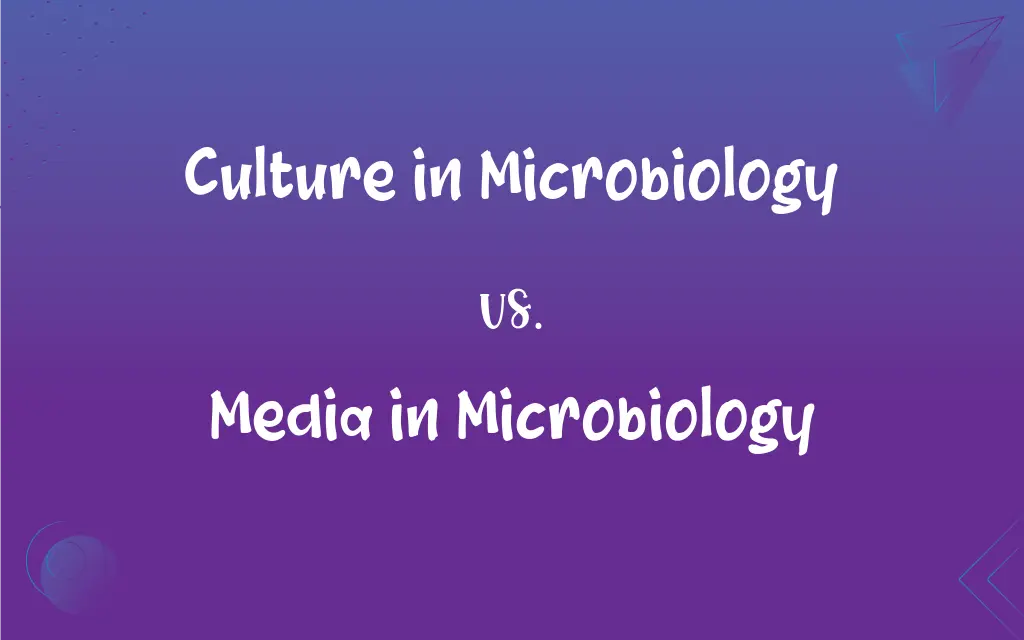Culture in Microbiology vs. Media in Microbiology: What's the Difference?
Edited by Aimie Carlson || By Harlon Moss || Published on March 4, 2024
Culture in microbiology refers to the growth of microorganisms in a controlled environment. Media in microbiology refers to substances used to support the growth of microorganisms.

Key Differences
In microbiology, a culture refers to the microorganisms that are grown under controlled conditions, often for the purpose of study or diagnostics. Media, on the other hand, are the nutrient-rich substances on which these microorganisms are grown, providing necessary conditions for growth and sustenance.
Cultures can consist of bacteria, viruses, fungi, or other microorganisms, and can be pure or mixed. Media can be solid (agar plates) or liquid (broth), and are composed of various nutrients, salts, and sometimes indicators to support and distinguish microbial growth.
Cultures are the actual samples of microorganisms being studied or tested. Media are the tools used to facilitate the growth and analysis of these cultures, playing a critical role in the accuracy and efficacy of microbiological studies.
Preparing a culture involves inoculating media with the microorganisms of interest. The media must be prepared with precise nutrient composition and sterilized to prevent contamination.
Cultures are used to study the characteristics, behaviors, and responses of microorganisms. Media are tailored for specific types of microorganisms or tests, influencing the results and interpretations of microbiological studies.
ADVERTISEMENT
Comparison Chart
Purpose
Grow and study microorganisms
Support and sustain microbial growth
Composition
Bacteria, viruses, fungi
Nutrients, salts, agar/broth
Laboratory Role
Subject of study or test
Growth environment
Preparation
Inoculation of media
Nutrient composition and sterilization
Use in Studies
Analysis of microbial properties
Facilitate specific microbial growth
ADVERTISEMENT
Culture in Microbiology and Media in Microbiology Definitions
Culture in Microbiology
Study of Microorganisms.
The culture was used to study antibiotic resistance.
Media in Microbiology
Solid or Liquid Form.
The liquid media was used for the broth culture.
Culture in Microbiology
Microbial Growth.
The bacterial culture showed rapid growth overnight.
Media in Microbiology
Growth Substance.
The agar media was prepared for bacterial growth.
Culture in Microbiology
Laboratory Sample.
She examined the fungal culture under the microscope.
Media in Microbiology
Nutrient-Rich Environment.
He added glucose to the media to support microbial growth.
Culture in Microbiology
Controlled Environment Growth.
Maintaining the right temperature is crucial for the culture.
Media in Microbiology
Sterilized Preparation.
The media must be sterilized to prevent contamination.
Culture in Microbiology
Diagnostic Tool.
A throat culture was taken to identify the infection.
Media in Microbiology
Selective Growth Support.
This specialized media is used to grow anaerobic bacteria.
FAQs
What is media in microbiology?
Substances that support the growth of microorganisms.
What is a culture in microbiology?
Growth of microorganisms under controlled conditions.
What are the types of media?
Solid (agar) and liquid (broth) are common types.
Why is culture important in microbiology?
It allows study and identification of microorganisms.
What is selective media?
Media designed to support the growth of specific microorganisms.
How do you identify microorganisms in a culture?
Through microscopic examination and biochemical tests.
What's the role of media in microbiology?
To provide a nutrient-rich environment for microorganisms.
What's the difference between agar and broth media?
Agar is solid, while broth is liquid.
Can cultures be mixed?
Yes, mixed cultures contain multiple microorganism types.
Why must media be sterilized?
To prevent contamination and ensure accurate results.
Can media be used for all microorganisms?
Different microorganisms may require specific types of media.
What's a pure culture?
A culture containing only one type of microorganism.
How are cultures maintained?
By providing optimal growth conditions like temperature and nutrients.
Why are cultures incubated?
To provide optimal temperature for microbial growth.
How long do cultures take to grow?
It varies, but many bacteria grow within 24-48 hours.
Can media affect the results of a culture?
Yes, the composition of media can influence microbial growth and behavior.
What's an example of a commonly used media?
Luria-Bertani (LB) agar is commonly used for bacterial cultures.
Are there risks in handling cultures?
Yes, proper safety protocols must be followed to prevent contamination and exposure.
Can viral cultures be grown on media?
Viruses require living cells to grow, so they need specialized media.
What is differential media?
Media that helps distinguish between different types of microorganisms.
About Author
Written by
Harlon MossHarlon is a seasoned quality moderator and accomplished content writer for Difference Wiki. An alumnus of the prestigious University of California, he earned his degree in Computer Science. Leveraging his academic background, Harlon brings a meticulous and informed perspective to his work, ensuring content accuracy and excellence.
Edited by
Aimie CarlsonAimie Carlson, holding a master's degree in English literature, is a fervent English language enthusiast. She lends her writing talents to Difference Wiki, a prominent website that specializes in comparisons, offering readers insightful analyses that both captivate and inform.
































































